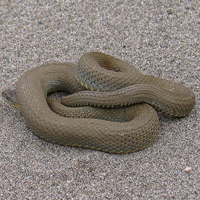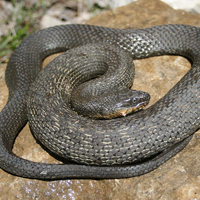Lake Erie watersnake
Scientific name: Nerodia sipedon insularum


Cover photo credits: Allen Woodliffe (left) and Scott Gillingwater (right)
Status
Special Concern
“Special Concern” means the species lives in the wild in Ontario, is not endangered or threatened, but may become threatened or endangered due to a combination of biological characteristics and identified threats.
Date added to the Species at Risk in Ontario List
The Lake Erie Watersnake was already assessed as endangered when the Endangered Species Act took effect in 2008. It was reassessed as special concern in June 2016.
Read the assessment report (PDF)
What it looks like
The Lake Erie Watersnake is a large, non-venomous snake that is only found on a few islands in Lake Erie. As its name suggests, this snake is highly aquatic and rarely found far from the shoreline.
It has a pale grey to dark brown body that may have a faint pattern of darker grey or brown bands. Females can reach over a metre in length.
Where it lives
Lake Erie Watersnakes spend most of the day in or near the water hunting for amphibians and fish. This snake prefers rocky shorelines with good shrub and tree cover.
The rocky beaches of the Lake Erie islands it inhabits provide abundant locations to bask in the sun as well as plentiful hiding places. During the fall, these snakes move a short distance inland to find suitable hibernation sites, called hibernacula.
Watersnakes have been known to hibernate in a variety of different sites where they can get below the frost line, including abandoned quarries, deserted cisterns, and in rock crevices.
Where it’s been found in Ontario
The global distribution of the Lake Erie Watersnake is limited to islands in the western end of Lake Erie, including Pelee Island. There are no current population estimates, but it is believed the population has declined over the past few decades.
View a larger version of this map (PDF)
What threatens it
The most significant threats to the Lake Erie Watersnake are habitat loss due to shoreline development and alteration, and human persecution.
Road mortality is also a serious threat for this species because snakes are slow moving, hard to see on the road and are sometimes intentionally run over.
Action we are taking
Special concern species do not receive species or habitat protection, but may be eligible for grants to help with their protection and recovery.
Recovery strategy
A recovery strategy advises the ministry on ways to ensure healthy numbers of the species return to Ontario.
Read the executive summary (March 2, 2015)
Read the recovery strategy (March 2, 2015)
Government response statement
A government response statement outlines the actions the government intends to take or support to help recover the species.
Read the government response statement (February 28, 2019)
Review of progress
A review of progress made toward protecting and recovering a species is required no later than the time specified in the species’ government response statement, or not later than five years after the government response statement is published if no time is specified.
Read the report on progress towards the protection and recovery of 12 species at risk, including Lake Erie Watersnake (2022).
Habitat protection
General Habitat Protection - June 30, 2008
What you can do
Report a sighting
- Report a sighting of an endangered animal or plant to the Natural Heritage Information Centre. Photographs with specific locations or mapping coordinates are always helpful.
- The Ontario Reptile and Amphibian Atlas also collects observations of all Ontario reptiles and amphibians. Submit your observations.
Volunteer
- Volunteer with your local nature club or provincial park to participate in surveys or stewardship work focused on species at risk.
Be a good steward
- Private land owners have a very important role to play in species recovery. If you find Lake Erie watersnake on your land, you may be eligible for stewardship programs that support the protection and recovery of species at risk and their habitats.
- If you come across a snake, please don’t try to capture it, handle it or kill it. Snakes can be delicate and improper handling can cause serious injury. Also, certain species are protected under legislation, which makes it illegal to harass, harm or kill them. Be respectful and observe from a distance.
- If you own lakefront property, maintain natural shorelines. You can enhance habitat by creating rock piles near the shoreline with good sun exposure where snakes can bask and hide.
- Watch for snakes that may be crossing roads between May and October. Road mortality is a serious threat to snakes because they are slow moving, hard to see on the road and are sometimes intentionally run over. If it is safe to do so, help snakes across the road in the direction they were headed.
- Never buy snakes that have been caught in the wild and never buy a native species of any kind that’s being sold as a pet.
Report illegal activity
- Report any illegal activity related to plants and wildlife to
1-866-MOE-TIPS (663-8477) .
Quick facts
- The Lake Erie Watersnake is not venomous. The only venomous snake in Ontario is the Massassauga rattlesnake, which is a reclusive snake that would rather flee than bite.
- Lake Erie Watersnakes can be a paler colour than watersnakes found elsewhere in Ontario. This is believed to be an adaptation that helps the snake camouflage on the pale limestone beaches characteristic of the islands it inhabits.
- When handled, watersnakes tend to respond defensively and may bite and release a foul odour.
- Watersnakes are well-adapted to life in the water and can dive to catch prey or to flee from predators.
- Snakes not only shed their skin, they also shed the outer layer of their eyes! Instead of eyelids, snakes have a see-through protective cap that covers the eye, called a brille.
